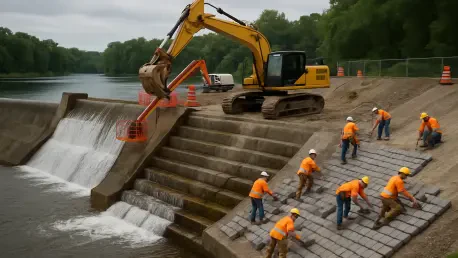In the heart of Wisconsin, a critical piece of infrastructure, the Rothschild Dam, stands as both a historical landmark and a pressing concern for safety and functionality, prompting a massive $60.2 million rehabilitation project to prevent potential collapse. Spanning 663 feet across the Wisconsin River, this 113-year-old structure, built in 1912 to power the Rothschild Mill and create Lake Wausau, has long been a cornerstone of local industry. However, with its aging timber spillway and diminishing role in energy production—currently supplying less than 10% of the mill’s needs—the dam’s condition has raised alarms. Despite millions spent on periodic repairs over the decades, federal oversight has deemed these fixes inadequate, highlighting the urgent need for a comprehensive overhaul. As Lunda Construction, a subsidiary of Tutor Perini, embarks on this ambitious modernization effort, the project not only aims to secure the dam’s future but also serves as a microcosm of a much larger national challenge surrounding aging infrastructure.
Modernizing a Century-Old Structure
The scope of the rehabilitation project at Rothschild Dam is both extensive and intricate, reflecting the complexities of updating a structure that has stood for over a century. Valued at $60.2 million, the contract awarded to Lunda Construction forms a significant portion of an $84 million initiative led by Domtar, the Montreal-based forestry products company that owns the dam. Key tasks include demolishing the outdated 276-foot-long timber spillway, which was last updated in 1964, and replacing it with a modern concrete structure designed for durability. Beyond this, the project entails installing deep foundations for enhanced stability, placing reinforced concrete, building a new control building, adding a prefabricated bridge, and integrating updated dam gates. Work began in mid-2025, with substantial completion targeted for early 2029. This timeline underscores the meticulous planning required to ensure that every component aligns with current safety standards while maintaining the dam’s historical significance to the region.
Equally important to the technical aspects is the context behind why such an overhaul became necessary for Rothschild Dam. Despite contributing minimally to the Rothschild Mill’s energy demands today, the dam remains a vital piece of infrastructure with deep ties to the community’s industrial heritage. Over the years, approximately $12 million has been invested in maintenance and repairs, yet these efforts have fallen short of addressing the underlying structural deficiencies. The Federal Energy Regulatory Commission has repeatedly flagged the inadequacy of piecemeal solutions, emphasizing that only a full-scale modernization can mitigate the risk of failure. This project, therefore, is not merely about preservation but about transforming an aging asset into a reliable and safe structure. By incorporating cutting-edge materials and design, the initiative aims to extend the dam’s lifespan for decades, setting a precedent for how historical infrastructure can adapt to contemporary demands without losing its original purpose.
Addressing a National Infrastructure Crisis
The rehabilitation of Rothschild Dam is emblematic of a broader, more pressing issue facing the United States: the deteriorating state of the nation’s dam infrastructure. According to a 2023 report by the Association of Dam Safety Officials, there are over 88,000 deficient non-federal dams across the country, with rehabilitation costs estimated at nearly $158 billion. Of this staggering figure, more than $34 billion is urgently needed for the most critical structures at high risk of failure. High-profile incidents, such as the dam failures in Michigan and the near-catastrophic breach at California’s Oroville Spillway, serve as stark reminders of the consequences of deferred maintenance. These events have amplified calls for investment in modernization projects, positioning efforts like the one in Rothschild as critical test cases. The scale of the challenge is daunting, yet it underscores the importance of targeted interventions that prioritize safety and resilience over temporary fixes.
Beyond the financial and logistical hurdles, the national dam crisis carries profound implications for public safety and economic stability, making projects like Rothschild Dam’s rehabilitation all the more significant. Aging dams often support local economies through energy production, flood control, and recreation, yet their failure can lead to devastating floods, loss of life, and billions in damages. The Rothschild project, while localized, mirrors the urgent need for systemic action to address infrastructure vulnerabilities across diverse regions. As billions in federal and private funding are debated and allocated over the coming years, the success of this $60.2 million endeavor could influence how resources are prioritized for other at-risk dams. Moreover, it highlights the necessity of collaboration between private entities like Domtar and skilled contractors like Lunda Construction to tackle complex engineering challenges, offering a potential blueprint for scaling up rehabilitation efforts nationwide.
Paving the Way for Future Solutions
Reflecting on the journey of Rothschild Dam’s rehabilitation, the groundwork laid by Lunda Construction over the past months marks a pivotal step toward averting disaster for a structure teetering on the edge of obsolescence. The commitment to replacing outdated components with robust, modern alternatives demonstrates a proactive approach to infrastructure challenges that have long been ignored. Each phase of the project, from demolition to the installation of new gates, is executed with an eye toward ensuring long-term stability, a testament to the meticulous planning that went into addressing decades of wear and tear.
Looking ahead, the completion of this project by 2029 should serve as a catalyst for broader action on dam safety across the nation. Stakeholders must leverage the lessons learned from this $60.2 million investment to advocate for increased funding and innovative engineering solutions for thousands of other deficient dams. Establishing public-private partnerships, as seen with Domtar’s leadership, could accelerate progress, while federal policies should prioritize high-risk areas to prevent future catastrophes. The path forward demands not just financial commitment but a cultural shift toward viewing infrastructure maintenance as a non-negotiable priority for community safety and economic vitality.









